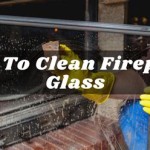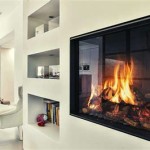Fans for Fireplace Inserts: Enhancing Heating Efficiency and Comfort
Fireplace inserts offer a significant upgrade over traditional open fireplaces, providing improved heating efficiency, reduced emissions, and enhanced safety. They are designed to fit within an existing fireplace opening and typically utilize a closed combustion system. However, even with these advancements, the natural convection heat distribution of a fireplace insert can be limited. This is where fans, specifically designed for fireplace inserts, play a crucial role in maximizing the benefits of this heating appliance.
A fireplace insert fan is a mechanical device designed to circulate the heated air generated by the insert into the surrounding room. Without a fan, much of the heat produced is concentrated near the fireplace, leading to uneven temperature distribution and potentially overheating the area immediately in front of the firebox. A fan actively draws cooler air from the room, passes it over the heated surfaces of the insert, and then distributes the warmed air back into the room. This forced-air circulation significantly improves the overall heating performance of the fireplace insert.
Improved Heat Distribution
One of the primary functions of a fireplace insert fan is to improve heat distribution throughout the room. Traditional fireplaces and even fireplace inserts without fans tend to create a localized hot zone near the appliance. This can be uncomfortable for those sitting close to the fireplace while leaving other parts of the room noticeably cooler. The temperature imbalance can also lead to inefficient heating, as the thermostat may not accurately reflect the actual temperature in the occupied areas of the room. A fan helps to eliminate these hot and cold spots by actively circulating the heated air, ensuring a more even and comfortable temperature throughout the entire space.
The mechanics of heat distribution are relatively straightforward. Cool air is denser than warm air and naturally settles near the floor. A fireplace insert fan positioned near the bottom of the unit draws this cooler air in. The air then flows over the heated surfaces of the firebox, absorbing the thermal energy. Finally, the warmed air is expelled back into the room, typically through vents located at the top or front of the insert. This continuous cycle of drawing in cool air, heating it, and then distributing it ensures that the heat reaches all corners of the room, promoting a more uniform temperature.
Consider a large living room with a fireplace insert located on one wall. Without a fan, the area immediately in front of the fireplace might be significantly warmer than the opposite end of the room. This temperature difference can be as much as 10-15 degrees Fahrenheit. With a fan installed, the warmed air is propelled across the room, reducing the temperature differential to a more manageable 2-3 degrees Fahrenheit. This improved temperature uniformity translates to greater comfort and reduces the need to overcompensate with other heating systems.
Increased Heating Efficiency
Beyond simply distributing heat more evenly, a fireplace insert fan also contributes to increased heating efficiency. By actively circulating the air, the fan allows the insert to transfer more of its heat energy into the room. Without a fan, a significant portion of the heat generated by the insert may be lost through convection up the chimney, or it may simply remain trapped around the firebox. A fan forces the heat outward, preventing it from being wasted and maximizing the amount of usable heat delivered to the living space.
The increased efficiency translates to a reduction in fuel consumption. Whether the fireplace insert burns wood, gas, or pellets, a fan can help to decrease the amount of fuel needed to maintain a comfortable temperature. This is because the fan allows the insert to heat the room more effectively, reducing the need to continually feed the fire or increase the gas flow. Over time, this reduction in fuel consumption can lead to significant cost savings, particularly for those who rely heavily on their fireplace insert for heating.
Furthermore, the improved efficiency can also extend the lifespan of the fireplace insert. By preventing the unit from overheating, the fan helps to protect the internal components from excessive wear and tear. This is particularly important for inserts that are frequently used for extended periods. The reduced stress on the system can lead to fewer repairs and a longer overall lifespan for the appliance.
To quantify the impact of a fan on heating efficiency, consider a scenario where a fireplace insert without a fan is able to heat a room to a comfortable temperature in four hours, consuming a certain amount of fuel. With a fan installed, the same room might reach the same temperature in three hours, consuming less fuel in the process. This reduction in heating time and fuel consumption demonstrates the practical benefits of using a fan to enhance the efficiency of a fireplace insert.
Types of Fireplace Insert Fans and Considerations
Fireplace insert fans come in various configurations, each designed to suit different types of inserts and installation scenarios. The most common types include blower fans, which are typically installed within the firebox or behind the insert, and convection fans, which are designed to circulate air around the exterior of the unit. The choice of fan depends on factors such as the size and design of the insert, the available space for installation, and the desired level of airflow.
Blower fans are generally more powerful and are capable of moving a larger volume of air. They are often used in larger fireplace inserts or in rooms that require more significant heating. However, blower fans can also be noisier than convection fans, which is a factor to consider for those who are sensitive to noise.
Convection fans, on the other hand, are typically quieter and more energy-efficient. They are well-suited for smaller inserts or for rooms where a gentle, consistent airflow is preferred. Convection fans are often mounted externally and do not require any modifications to the fireplace insert itself.
When selecting a fireplace insert fan, it is important to consider the airflow rate, measured in cubic feet per minute (CFM). The appropriate CFM rating depends on the size of the room and the heating capacity of the insert. A larger room will require a fan with a higher CFM rating to effectively distribute the heat. It is also important to check the noise level of the fan, measured in decibels (dB), to ensure that it will not be disruptive.
Installation of a fireplace insert fan can vary depending on the type of fan and the design of the insert. Some fans are designed for easy DIY installation, while others may require professional installation. It is crucial to follow the manufacturer's instructions carefully to ensure that the fan is installed correctly and operates safely.
Maintenance of a fireplace insert fan is relatively simple. Regular cleaning of the fan blades and motor is essential to prevent dust and debris from accumulating, which can reduce airflow and increase noise. It is also important to check the fan's electrical connections periodically to ensure that they are secure. Some fans may also require occasional lubrication of the motor bearings to maintain optimal performance.
The use of a fireplace insert fan is an effective way to enhance the heating efficiency and comfort provided by a fireplace insert. By improving heat distribution, increasing heating efficiency, and offering a variety of types to suit different needs, these fans are a valuable addition to any fireplace insert system. Proper selection, installation, and maintenance of a fireplace insert fan can significantly improve the overall performance and longevity of the heating appliance.
In conclusion, a fireplace insert fan is not merely an accessory but a vital component that unlocks the true potential of the heating appliance, contributing to a warmer, more comfortable, and energy-efficient home environment.

Why Should I Get A Fireplace Blower For My Masonry

Fireplace Efficiency Blowers And Why You Should Have One

What Are Fan Assisted Fireplaces Like How Do These Fans Work Panadero

What Are Fan Assisted Fireplaces Like How Do These Fans Work Panadero

Fireplace Blower Fans What You Need For Heat Full Service Chimney

How To Replace Your Rsf Fireplace Blower Fan

Sirocco Plus Stove Fan Reviews

What Are Fan Assisted Fireplaces Like How Do These Fans Work Panadero

Fireplace Blowers Explained How Fans Work Regency

Noisy Gas Fireplace Blower Here S How To Replace It Diy
Related Posts








